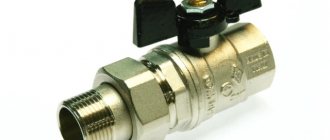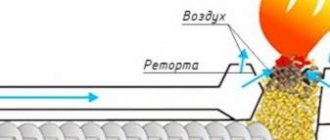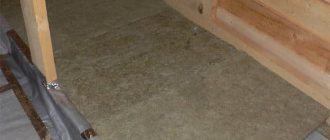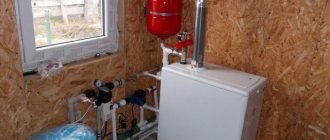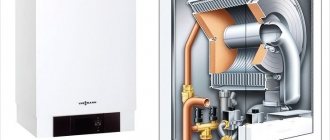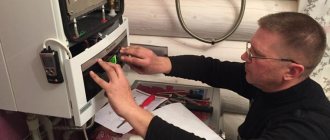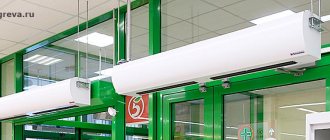The device for drying hygiene items and removing excess moisture in the bathroom is simple to design and install. In order to install it, you do not need fundamental knowledge in the field of engineering communications construction.
However, you should clearly know how to connect a heated towel rail. After all, the result of your own efforts or the work of hired plumbers should please you for many years, do you agree?
In the article we presented, all options for installing a substation and possible complications during its connection are discussed in detail. Verified and systematized information will be a reliable help for home craftsmen who want to do the work themselves, or who want to control the actions of workers.
We have outlined in detail the specifics of connecting an important household appliance in old and new bathroom layouts. The problems of private home owners have not been left unattended. The information we offer has been tested in practice, supported by visual materials and video instructions.
Is it possible to connect a towel dryer to the hot water supply?
Yes you can.
Moreover, connecting devices to the hot water riser allows you to organize uninterrupted operation of the heated towel rail throughout the year. All the disadvantages of the traditional method are eliminated, the bathroom is always warm and dry.
In addition, the method of accounting for utilities is changing - when a heated towel rail is powered from a hot water riser, it ceases to be considered a heating device, and the thermal energy consumed is taken into account only as the cost of heating water for domestic hot water.
Materials for work
In private homes, water heated towel rails are mainly installed, which are connected directly to the heating system.
When connecting the device, you must use the following materials:
- shut-off valves;
- fittings – couplings, bends, bends;
- air vent valve;
- mounting tow or tape;
- fastening elements - dowels, brackets, bolts, screws.
To connect a heated towel rail in a private house, you will need an installation tow.
Experts recommend installing a bypass on the heated towel rail, which is a piece of pipe with tees at the edges. In this case, ball valves are mounted at the ends of the dryer.
Basic installation rules
Powering the substation from the DHW line should not violate the rights of other users. Therefore, the installation of devices must be carried out in compliance with all requirements and standards.
The basic rules for connection are:
- using bypass;
- the absence of shut-off valves on the bypass, which can be used to cut off users of the upper floors from the hot water supply;
- the distance from the riser to the substation should not exceed 2 m so that the water temperature remains within standard limits;
- The bypass capacity must meet the technical requirements for a given network and not interfere with the water supply to other subscribers.
In addition, it is necessary to take into account the characteristics of water circulation . When installing the device at a great distance from the riser, it is necessary to ensure a slight slope of the pipes - on the lower branch the pipe slopes towards the riser, and on the upper branch - away from it. This allows for the free removal of air bubbles and increases the intensity of circulation.
Often these rules are violated by management company employees themselves, who use obviously unsuitable types of pipes or incorrect connection methods. Therefore, to avoid errors, the apartment owner should have a clear understanding of the correct connection of the substation to the pipeline.
Operating principles of the heating system
This connection option does not pose any technical difficulties. A heated towel rail is a heating device installed in almost every city apartment. From a constructive point of view, this is an external element of communications through which hot coolant or hot water of the DHW system circulates. Such elements are often installed as a compensating loop of the heating system, playing the role of an additional source of heat in rooms with high humidity. The name of the element speaks for itself, hence the serpentine shape, thanks to which you can effectively use the heated circuit.
For aesthetics, heated towel rails are usually made of stainless steel or plated with nickel. The design itself and the method of connecting the heated towel rail to the centralized communication make it possible to connect a water floor pipe to it without much difficulty. As a rule, small diameter pipes are used for heated floors. For a bathroom, the area of which rarely exceeds 4-5 m2 in a city apartment, only 15-20 meters of pipe will be required.
There are two types of heated towel rails:
- a coil that is connected to a centralized heating system;
- a coil that is connected to a centralized hot water supply.
In the first case, with the onset of the heating season, water fills the heated towel rail and accordingly enters the heated floor circuit, heating the floor surface.
The first option only works during the heating season. The rest of the time your heated floor will be inactive. A coil connected to the DHW system looks preferable. Such a floor in the bathroom will always work, providing a good microclimate and comfortable temperature.
How does the shape of the device affect installation?
The efficiency of water circulation and the absence of stagnant or airy areas depend on the shape of the heated towel rail.
The most effective are U- or M-shaped structures that do not have complex intersections or bends.
Water enters them from one end of a curved pipe and leaves the other without changing its speed or stopping.
However, modern substation designs, made in the form of ladders or in the form of complex spatial lattices, are more convenient for operation. They provide more options for drying towels, but require proper connection.
Types of American taps for heated towel rails
Straight American cock
American cranes can be classified according to several criteria. For example, according to their design, there are two types: petal and lever valves. For installation of heating system elements, petal-type devices are more often used. Lever valves are usually installed on smaller diameter pipes.
There are also straight and corner American fittings for heated towel rails, designed for straight sections of water supply and corner connections, respectively.
The fitting material can also be different:
- brass coated with chrome or nickel;
- cast iron;
- steel, usually stainless;
- combined materials with polypropylene inserts.
According to the type of connecting joints, “American” ones can be divided into two groups:
- Cylindrical: fittings are sealed using gaskets made of rubber, polyurethane or paronite. The seal in the connection needs to be replaced regularly. And the connection itself must be tightened regularly.
- Conical ones do not require additional sealing, so they are often used when installing heated towel rails. They have a longer service life and create a uniform joint.
Note: if the deviation of the pipe axes is no more than five degrees, the connection with the cone valve will be absolutely sealed, resistant to temperature changes and other influences.
Connection diagrams in the apartment
The operation of a heated towel rail requires constant circulation of water. If its shape is close to the standard U- or M-shaped types, only one connection option is possible.
If a modern substation design with several connection points is used, you will have to choose the best option. This issue should be taken seriously, since it will be extremely difficult to correct the mistakes made.
Existing options
There are several ways to connect a substation to a hot water riser. All of them apply only to complex structures that have 4 connection points (in the form of a ladder).
Depending on the configuration of the room, the size of the substation and other factors, different schemes can be used:
Upper. Direct and reverse taps are connected to the upper points of the substation.- Bottom. The forward and return pipelines are connected to the lower connecting elements.
- Lateral. For connection, use one upper and one lower connecting elements located on one side of the device.
- Diagonal. Upper and lower connecting elements are used, located on different sides of the ladder.
- In the center. This connection option is less common. The ladder has only 2 connection points located on the upper and lower rungs.
All options have their pros and cons. It is difficult to clearly name the best connection method, since many factors affecting the operating conditions of the device must be taken into account.
How to choose the right method?
The choice of the optimal connection method is determined by the need to get the maximum benefit from the heated towel rail and eliminate the loss of thermal energy. To do this, it is necessary to ensure water circulation and the absence of stagnant or airy areas.
It is necessary to take into account the size of the device, width and number of crossbars. In addition, the direction of supply (from above or below), the pressure in the system and the speed of water movement should be taken into account.
Most experts consider side mounting to be the best option.
It has minor drawbacks, but allows for a minimum of thermal energy losses and ensures efficient water circulation.
The bottom connection can be used in any direction of flow in the riser. The upper type of connection creates the danger of water stagnation in the lower part of the device, where the cooled layers sink.
Designs with centrally located pipes are considered the most successful, but they are much less common on sale.
In addition to the connection points, a properly functioning bypass is required. This is a straight section of the riser located between the branches at the substation. There should not be any valves on it, and the internal diameter should not be reduced relative to the rest of the pipeline.
Sometimes the bypass is shifted relative to the common spine of the riser. This is done only in systems of private houses, since there is a danger of changing the flow parameters.
All these options apply only to ladder-shaped devices. Conventional U- or M-shaped heated towel rails have only two connection points and are connected in a single way.
What schemes should you avoid?
First of all, it is necessary to avoid the use of complex bends that are curved and form vertical loops. Air bubbles form in them, which impede the movement of water. In addition, it is necessary to maintain the slope of the branches.
Often, apartment owners, wanting to hide pipes, lay them in a concrete floor screed or under a suspended ceiling. This creates extended loops where stagnant areas form and air accumulates.
In systems with low operating pressure (usually this happens in autonomous lines of private houses), it is necessary to take into account the direction of supply . There are often situations when forced circulation begins to compete with natural circulation.
Hot water enters the substation, cools down in it and begins to fall down. In such cases, the flow either passes along one path without heating the rest of the heated towel rail, or stops altogether.
What designs are there?
Heated towel rails come in different shapes. When choosing them, people are often guided solely by aesthetics, which is not entirely justified. These devices work normally with good water circulation, but not all models provide such circulation. With some you have to spend a long time trying to find the right connection diagram, otherwise they simply refuse to work.
So, all heated towel rails can be divided into four groups:
- U-shaped or U-shaped. The simplest models, basic connection (lateral). Ideally, when replacing the old one, you find a model with the same center distance. Then, if you're lucky, you won't even have to redo the bends.
- Ladder. Modern designs with a certain number of crossbars. Also a good option from a hydraulic point of view. The connection can be bottom, side or diagonal. But it is not chosen arbitrarily, but according to a set of conditions (where the supply comes from, location relative to the riser).
- Snake. Another classic model with side connection. Installing a heated towel rail of this type, as a rule, does not present any problems.
Types of heated towel rails - Complex shape. There are very unusual heated towel rails. They can even be an interior decoration, but their proper connection is a problem. As a rule, consultation with a competent specialist, a plumber who is well versed in hydraulics, is required. As you understand, finding one is not an easy task.
It often happens that after installing a heated towel rail it simply does not work. If the error is serious, the riser to which it is connected also stops working. Therefore, it is necessary to know and follow the connection rules.
Step-by-step instruction
There are many options for connecting the substation to the riser, so it is necessary to consider them separately.
Lateral horizontal installation
This option is simple and popular.
To connect, you must perform the following steps:
- Using standard fasteners, install the heated towel rail on the wall;
- Mark the tie-in points on the riser. They must be located so that the required angle of inclination of the bends is maintained.
- Turn off the water in the riser, drain the remaining water and relieve the pressure (just open the tap).
- Cut out a section of pipe, or burn holes in it for bends.
- Measure and cut two pieces of pipe from which the elbows will be made. Shut-off valves are immediately installed - usually ball valves.
- Weld the bends directly to the riser or using fittings (tees).
- Connect the pipelines to the heated towel rail using “American” nuts (internal threaded union nuts).
Taps should not be placed on the bypass, so as not to accidentally turn off the water for other users. There are two bypass design options that should be especially considered.
Narrowed bypass
Often the bypass is made from a pipe with a diameter that is one register smaller. Usually, they simply weld a piece of thinner pipe inserted into the gap. This is done in order to redistribute the flow in the straight section of the riser.
This method allows you to increase the flow of water into the heated towel rail, which makes it work more efficiently. However, if you need to turn it off, the DHW supply mode will change. This is noticeable even when installing a narrowed bypass in one apartment.
Since this method creates the possibility of violating water supply regulations, its use is considered a risky and undesirable solution.
Not narrowed bypass
A non-narrowed bypass allows you to maintain the throughput of the riser. This is the best option to ensure that the technical characteristics of the system are maintained.
However, in this case, the operating efficiency of the PS may be reduced due to the high hydrodynamic resistance of the device. If the heated towel rail has a large volume with many bars, stagnation of cooled water may occur, stopping the flow into the device.
Another thing to pay attention to is the size of the ball valves. If their capacity is too small, the flow will enter the PS with low intensity, reducing the efficiency of the device. It is recommended to take care in advance of purchasing taps that do not reduce the cross-section of the pipe.
Bottom installation
The lower connection allows you to connect pipes without making channels in the walls (without gating).
However, it is necessary to ensure that the tie-in points into the riser are at a distance of at least 50 cm from each other and are located below the connecting elements of the substation. With this method, it does not matter whether the water is supplied from below or from above.
Installation procedure:
- Install the device on the wall using the supplied fasteners.
- Turn off the water and relieve pressure. Mark the connection points for the branches on the riser.
- Cut a section of pipe and install fittings (or burn holes to directly connect metal pipes).
- Make bends with installed ball valves.
- Connect the outlets to the riser and to the heated towel rail.
The photo shows a connection diagram for a heated towel rail with bottom outlets:
This option is convenient because for repairs you do not have to destroy most of the finishing of the room.
Diagonal installation
This is a variant of lateral connection, in which the lower outlet is made from the distant connecting element.
Procedure:
- The device is installed on the wall.
- The water is turned off, and the installation points for outlets with the required slope are marked on the riser.
- Branches with shut-off valves are prepared.
- The short (upper) and long (lower) branches are connected.
This connection option can be done in reverse - a long outlet on top, a short one on the bottom. The main requirement is that the diameter of the bypass and riser must be equal.
Operating experience shows that the diagonal method has no advantages over the usual lateral method.
Universal option
Universal connection is not a separate option, but another name for the lower connection method.
The term arose due to the high efficiency of the PS installed in this way. The procedure is no different from that discussed above, all requirements are also similar.
Sometimes there is another interpretation of the term, when it refers to the connection of a conventional U- or M-shaped heated towel rail. Since the term does not have an exact formalized definition, discrepancies may arise.
Additional types of connection
There are other installation schemes for a heated towel rail:
- With offset bypass. This option is used to enhance the flow energy entering the device. In direct flow, water moves more actively along the riser, which can cause stagnation and cooling of the flow in the substation. The design of the offset bypass provides for a smooth bend of the inlet sections of the riser adjacent to the outlets and bypass. The flow is directed horizontally, which increases the efficiency of the substation.
- With central connecting element. This method is simple because the device has only two connecting elements. Installation consists of installing the substation on the wall and assembling taps for the hot water riser.
These options are used less frequently - the first is more labor-intensive and requires experience from the master, and the second is simply relatively rare.
How to make bends and how to change the riser
If the riser is metal and you are not going to change it, then installing a heated towel rail is possible with steel or polypropylene pipes. If you change the riser (the best option) and install polypropylene, there is no choice - PPR pipes are also used for bends. Use polypropylene for hot water, preferably reinforced with fiberglass.
Why is metal-plastic not suitable? Because its fittings have a very narrow clearance. This has a very bad effect on circulation. As a result, even 100% efficient circuits do not provide normal heating.
Installation of a heated towel rail with polypropylene pipes
A little about why to change the riser. It makes sense to do this in old houses when renovating a bathroom or bathroom (depending on where your riser is located). Firstly, the pipes are usually already old and worn out. Even welding an outlet to them can be problematic, the metal is so worn out. Secondly, modern renovations involve hidden installation of communications and you will also want to cover the riser. Hiding an old pipe and then destroying everything again a few years later... is not a good solution.
A little about how to change. You need to come to an agreement with the neighbors below and above, as well as with the housing office (DEZ, UK). With your neighbors that you will cut off their riser and install a new one on the thread. Why do they have it? Because leaving an old pipe in the ceiling is dangerous: it will collapse and leak. It will flood you or your neighbors below. Therefore, it is better to pass through the ceilings with a new pipe.
With this connection, the dryer is part of the riser and there cannot be any taps
Having agreed or not with your neighbors (their riser may already be closed), you go to the housing office and agree on the date of replacement and the time for which the riser will be turned off. The work can be done by “local” mechanics, you yourself (if you have welding qualifications) or people you hire. After the connection, the water is turned on, you check the functionality of the heated towel rail and the system as a whole. If it doesn’t start to cool within 30 minutes, it means it’s set correctly. This completes the replacement or installation of the heated towel rail.
Common mistakes
The main and unacceptable mistake is the absence of a bypass, or the installation of a ball valve on it.
If it is closed, hot water will stop flowing to other apartments located further along the riser.
Another mistake is excessively narrowing the bypass. As a rule, plumbers motivate their actions by the fact that there is no difference - the water still passes through the substation and returns to the riser.
However, if the device is shut off, the water pressure for other subscribers decreases sharply. In MKD systems, the difference between standard and changed pressure becomes critical.
In addition, bends from the riser are often made that have humps, a lot of curved sections , and fittings. All these elements create the possibility of the formation of air bubbles that stop circulation.
Correcting these errors without completely reworking the connection is impossible.
The best option is to think through the installation process in advance and avoid making any mistakes.
